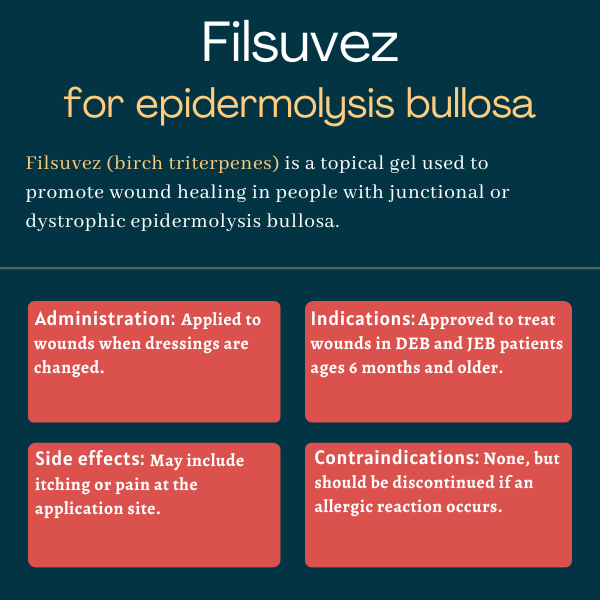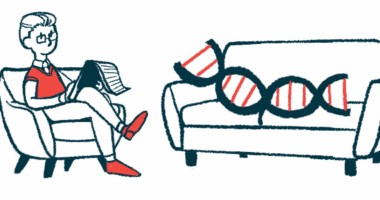
Filsuvez (birch triterpenes) for epidermolysis bullosa
What is Filsuvez for epidermolysis bullosa?
Filsuvez (birch triterpenes), previously known as Oleogel-S10 or AP101, is a topical gel that’s approved to help promote wound healing in people with dystrophic epidermolysis bullosa (DEB) or junctional epidermolysis bullosa (JEB). It specifically is indicated for the treatment of partial thickness wounds, which are wounds that do not extend past the skin’s dermis layer.
The therapy originally was developed by Birken AG. Amryt Pharma then acquired Birken, and in 2023, Amryt was acquired by Chiesi Global Rare Diseases, which now markets Filsuvez.
In the European Union, a similar topical treatment received marketing authorization in 2016 under the brand name Episalvan for the treatment of wounds — but not specifically for EB patients. Instead, it was indicated for the treatment of adults with partial thickness skin wounds. That authorization was withdrawn in 2022, however, at the request of Amryt, which opted to discontinue the therapy’s production.
Filsuvez, meanwhile, has also been approved in the EU for the treatment of DEB and JEB.
Therapy snapshot
| Brand name: | Filsuvez |
| Chemical name: | Birch triterpenes |
| Usage: | Promotes wound healing in dystrophic and junctional EB |
| Administration: | Topical |
How does Filsuvez work?
Both DEB and JEB are caused by gene mutations that result in abnormally fragile skin that’s prone to wounds and blistering. Filsuvez has been shown to promote healing of wounds in these types of EB, though the therapy’s exact mechanism of action is not fully understood.
The active ingredient in the gel is an extract from birch tree bark that contains a group of biologically active chemicals called triterpenes.
It’s thought that these chemicals promote wound healing through two general pathways: Data suggest that Filsuvez treatment can help to reduce inflammation after a first pro-inflammatory effect, and second, the therapy is believed to prompt a type of skin cell called keratinocytes to grow and mature to maintain the skin barrier.
Who can use Filsuvez?
Filsuvez was approved by the U.S. Food and Drug Administration (FDA) in late 2023 as a treatment for partial thickness wounds associated with DEB or JEB. It’s indicated for adults and children ages 6 months or older.
The topical gel also has been approved for these indications by the European Commssion — which covers all member states of the European Union plus Iceland, Norway, and Liechtenstein — as well as in Great Britain, which comprises England, Scotland, and Wales.
Who should not use Filsuvez?
The prescribing information for Filsuvez does not list any contraindications, but does note that some people have experienced allergic reactions to the therapy. If signs of an allergic reaction appear, Filsuvez should be discontinued immediately.
How is Filsuvez administered?
The therapy should be applied when wound dressings are changed until the wound is healed. Filsuvez can either be applied as a thin (about 1 mm thick) layer directly on the wound, or the gel can be put on dressings so it will be in contact with the wound once the dressings are applied.
Filsuvez gel should not be rubbed into wounds. Also, the gel is only meant for application on the skin; it should not be ingested or used in the mouth, anus, vagina, or eyes.
The medication is available in one-time-use tubes containing 25 mL of the gel.
Filsuvez in clinical trials
Phase 2 study
The first clinical trial to test Filsuvez in people with EB was a small proof-of-concept study called BEB-10 (NCT01294241). It involved 10 participants with 12 pairs of wounds among them — for each wound pair, one was treated with Filsuvez and the other was covered only with a nonadhesive wound dressing.
The study’s main goal was to compare whether Filsuvez led to better re-epithelialization — that is, closing over of the wound with new healthy skin — after two weeks for recent wounds or four weeks for more long-lasting wounds. The extent of re-epithelialization was judged by two independent reviewers.
The results showed that both reviewers agreed that Filsuvez outperformed the control covering at promoting healing for five of the 12 wound pairs assessed. There also were three wound pairs where one reviewer, but not the other, judged Filsuvez as superior.
Phase 3 EASE trial
The FDA’s approval of Filsuvez was based primarily on results from a Phase 3 clinical trial called EASE (NCT03068780).
That study enrolled 223 people with DEB or JEB, ranging in age from infants to adults. Most participants specifically had recessive DEB. The trial also was open to people with a rare form of EB called Kindler syndrome, but no patients with this condition were enrolled.
For each of the patients enrolled, one target wound was selected. Each target wound was 10 to 50 square centimeters in size; the wounds had to have persisted for at least three weeks, but less than nine months.
For half of the participants, Filsuvez was applied to wounds at dressing changes at least once every four days. The other half of participants were administered a placebo gel. The study’s main goal was to compare the rates of target wound closure within 45 days.
At that time point, 41.3% of patients treated with Filsuvez had wound closure compared with 28.9% of those given the control gel, the results showed. Statistically, that worked out to a 44% increased likelihood of wound closure with Filsuvez.
Reductions in target wound size over 90 days further supported these findings. However, the time to first target wound closure over 90 days did not differ significantly between the two groups.
Longer-term findings showed a reduction in wound burden of more than 50%, on average, after more than a year of Filsuvez treatment.
Subgroup analyses showed Filsuvez significantly outperformed the control among patients with recessive DEB, accounting for the majority of study participants. In dominant DEB and JEB patients, there weren’t significant differences in healing rates between Filsuvez and the control gel. However, because there were only about two dozen patients with each of these EB types, it was likely that the analyses didn’t have the statistical power to detect a meaningful difference.

Side effects of Filsuvez
The most common side effects of Filsuvez reported in clinical trials were reactions at the application site, such as itching or pain.
Allergic reactions
Allergic reactions to Filsuvez have been reported, with possible symptoms including hives, known as urticaria, and skin inflammation, or dermatitis. If an allergic reaction occurs, the use of the gel should be immediately discontinued and appropriate supportive treatment should be administered at once.
Use in pregnancy and breastfeeding
Filsuvez has not been studied in people who are pregnant or breastfeeding, so its effects in these situations are impossible to know with certainty. However, pharmacological data suggest that, when the gel is applied to the skin, very little of its active ingredients are absorbed into the bloodstream. Therefore, Filsuvez is not expected to have any noteworthy effects during pregnancy or breastfeeding.
Epidermolysis Bullosa News is strictly a news and information website about the disease. It does not provide medical advice, diagnosis, or treatment. This content is not intended to be a substitute for professional medical advice, diagnosis, or treatment. Always seek the advice of your physician or other qualified health provider with any questions you may have regarding a medical condition. Never disregard professional medical advice or delay in seeking it because of something you have read on this website.
Recent Posts
- New mesh-free dressing promotes skin wound healing in EB: Trial data
- Double dose of Vyjuvek safely heals extensive wounds in woman with RDEB
- Searching for a faith community that fulfills our family’s needs
- Repurposing existing medicines may offer faster route to new EB treatment
- Approved psoriasis drug apremilast to be tested in severe EBS patients
Related articles
 Fact-checked by
Fact-checked by 



